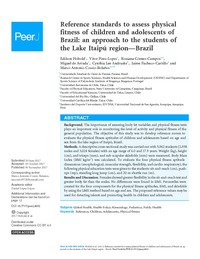Reference standards to assess physical fitness of children and adolescents of Brazil: An approach to the students of the Lake Itaipú region—Brazil
Autor
Hobold, Edilson
Pires-Lopes, Vitor
Gómez-Campos, Rossana
De Arruda, Miguel
Lee-Andruske, Cynthia
Pacheco-Carrillo, Jaime
Cossio-Bolaños, Marco Antonio
Fecha
2017Resumen
Background. The importance of assessing body fat variables and physical fitness tests plays an important role in monitoring the level of activity and physical fitness of the general population. The objective of this study was to develop reference norms to evaluate the physical fitness aptitudes of children and adolescents based on age and sex from the lake region of Itaipú, Brazil. Methods. A descriptive cross-sectional study was carried out with 5,962 students (2,938 males and 3,024 females) with an age range of 6.0 and 17.9 years. Weight (kg), height (cm), and triceps (mm), and sub-scapular skinfolds (mm) were measured. Body Mass Index (BMI kg/m2) was calculated. To evaluate the four physical fitness aptitude dimensions (morphological, muscular strength, flexibility, and cardio-respiratory), the following physical education tests were given to the students: sit-and-reach (cm), pushups (rep), standing long jump (cm), and 20-m shuttle run (m). Results and Discussion. Females showed greater flexibility in the sit-and-reach test and greater body fat than the males. No differences were found in BMI. Percentiles were created for the four components for the physical fitness aptitudes, BMI, and skinfolds by using the LMS method based on age and sex. The proposed reference values may be used for detecting talents and promoting health in children and adolescents.
Fuente
PeerJ, 5, e4032Identificador DOI
doi.org/10.7717/peerj.4032Colecciones
La publicación tiene asociados los siguientes ficheros de licencia:


